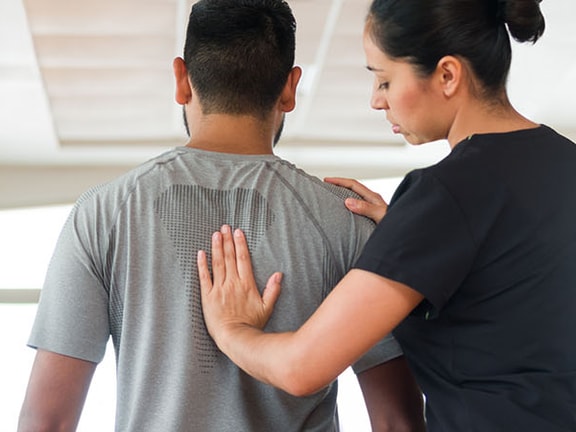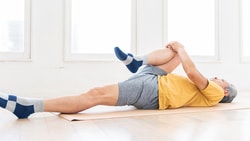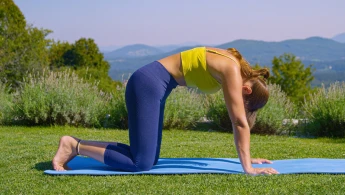Exercises and Education for Treating Ankylosing Spondylitis
May 21, 2024
5 min. read

Ankylosing spondylitis (AS) is a chronic and likely genetic inflammatory disease. People with these characteristics are more likely to develop AS:
Carry the HLA-B27 geneAlthough carrying the gene makes developing AS more likely, 80 percent of people who carry the HLA-B27 gene do not develop AS.
Are aged between 17 and 45, with an average age of 24.
Are male Men who have AS also have more severe symptoms than women.1
What Are the Typical Symptoms of Ankylosing Spondylitis?
The most common symptom of AS is pain and stiffness in the sacroiliac joints at the base of the spine and lower back, as well as potentially in the hips and shoulders. Pain is especially worse in the middle of the night and can often lead to morning stiffness that lasts more than one hour and/or stiffness after long periods of being inactive. Both kinds of stiffness often improve with exercise or physical activity. People with AS may also experience general fatigue and poor sleep.
AS affects both muscles and joints and also causes:
Inflammation where ligaments and tendons attach to the bone. This inflammation can lead to fusion of the sacroiliac joints in the pelvis, hips, and spine, including the neck.
Stiffness, which may get worse over time and can reduce the patients ability to turn their head, stand upright, or bend.
Poor posture: With problems maintaining good posture, people with AS may stoop forward, which can lead to difficulty walking and increased risk of falling. The stooped posture may also increase stress and pain in the spine.
Difficulty breathing: The joints where the ribs and spine attach may become stiff and limit chest and lung expansion. This stiffness can lead to shortness of breath and increased risk of lung infections.
Eye issues: In about 40 percent of cases, AS can affect the uveitis or soft tissues of the eye. If the eye is affected, a person may have eye pain, blurred vision, and increased sensitivity to light.
Skin conditions like psoriasis and inflammatory bowel disease, which can cause abdominal pain, diarrhea, and/or weight loss.
Heart and kidney issues in rare occasions.
How Is Ankylosing Spondylitis Diagnosed?
If AS is suspected, diagnostic tests may include an x-ray or MRI of the spine, hips, and sacroiliac joints. The patients doctor may order blood and genetic tests. If the patient tests positive for the HLA-B27 gene, it might mean they are at a higher risk for developing AS.
Managing Ankylosing Spondylitis
As a physical therapist or occupational therapist, you can help your patients with AS by developing a treatment plan specific to their condition and goals. These may include:
Patient education: Educate your patient about AS and help them make decisions about their physical activities. 94 percent of patients confirmed they would access patient education materials from their clinicians if they were available.1 To help your patient understand their condition, you can assign patient education, like the ankylosing spondylitis video shown below.
Posture training: Focus on improving your patients posture to avoid slouching or forward bending in order to reduce pain in the spine and other joints as well as decrease the risk of falling.
Strengthening exercises: Provide exercises that strengthen the neck and abdominal muscles, which helps reduce pain and improves posture, improving your patients ability to walk upright.
Flexibility exercises: Prescribe range-of-motion and flexibility exercises, which help keep the spine and other joints from getting stiff. These exercises may include stretching the pectoral muscles, hip flexors, hamstrings, quadriceps, and calves as well as helping improve seated cervical pain as well as thoracic extension and lumbar extension in standing or lying.
You can create and manage personalized exercise and education programs for your patients through our Home Exercise Program Builder.
Medbridges HEP Library includes numerous exercises for ankylosing spondylitis, including:
Seated Cervical Retraction and Extension
Seated Thoracic Lumbar Extension
Seated Trunk Rotation
Hip Flexor Stretch with Chair
Seated Hamstring Stretch with Chair
Prone Quadriceps Stretch with Strap
Below, see these ankylosing spondylitis exercises in action from Medbridge's HEP Library:
Corner Pec Major Stretch
Standing Lumbar Extension with Counter
Standing Bilateral Gastroc Stretch with Step
Aerobic exercises: Advise your patient to do low-impact exercises such as walking, swimming, or bike riding, which also reduce the risk of heart disease and fatigue while they help build endurance.
Deep breathing exercises: These exercises help improve chest expansion by increasing oxygen and blood flow in the body. Getting enough blood flow and oxygen throughout the body can help decrease pain, stiffness, and fatigue.
Movement retraining: Teach your patient how to move efficiently while conserving energy. Since patients with AS experience significant loss of joint mobility, decreased flexibility, inflammation, and associated pain, it is important to teach them how to pace themselves to perform functional activities.
Surgery: If your patients hip joints have become fused, causing difficulty with movement, hip replacement surgery may be an option. The goal after surgery is to regain joint mobility, flexibility, and strength, improving the ability to walk, balance, and navigate stairs and reducing the risk of dangerous falls.
You can help your hip replacement patients navigate surgery using the Medbridge HEP Builder. You can assign education and exercises as part of a prehab program before surgery, and can use templates to assign a phased rehab plan post-surgery. Learn more about the HEP Builder.
Can Ankylosing Spondylitis Be Prevented?
AS is a genetic disease, there is no way to prevent it. However, you can help your patients improve their physical function to their highest level possible and manage their symptoms by designing and prescribing exercise programs specific to their condition for stretching, strengthening, and conditioning through Medbridge's Home Exercise Program.
Below, watch Cheryl Lehman discuss ankylosing spondylitis treatment in this brief clip from her MedBridge course, “A Longer Look at Arthritis for Rehabilitation Nurses."






